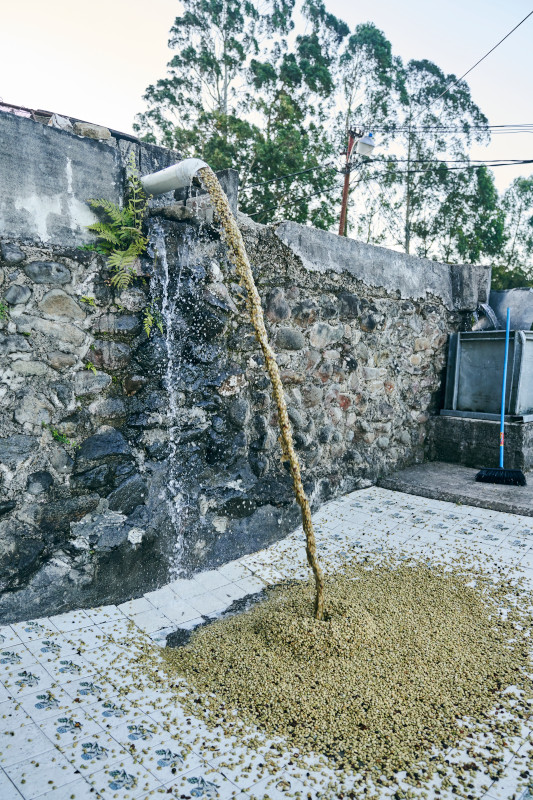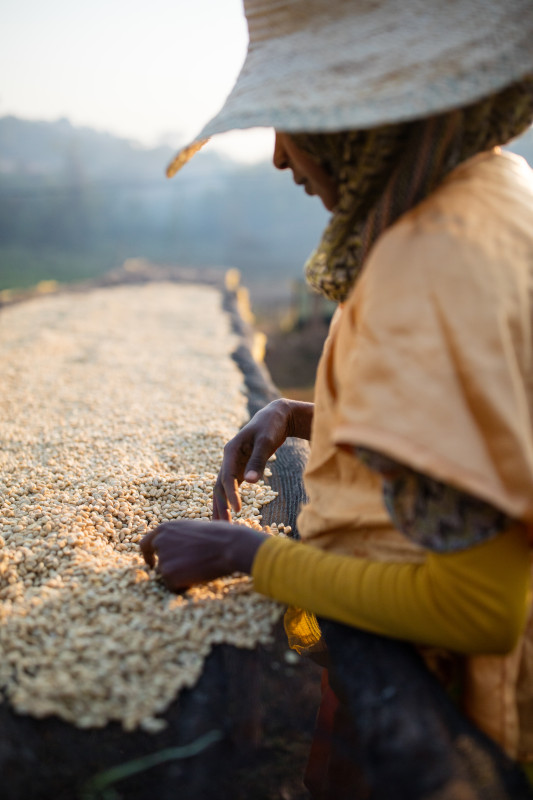
Washed, Natural, and Wet-Hulled Coffee Processing
How do you like your coffee: washed, natural or wet-hulled?
If you want to know what that means before answering, the first thing you should understand is that coffee is actually the fruit of a tree. In fact, it’s the cherry of the Coffea genus. Unlike the cherries we eat, the coffee cherry usually contains two seeds (beans). Because that’s what coffee beans are: the seeds of the fruit. And post-harvest processing—what happens to the fruit after it’s been picked off the tree—is all about getting to those seeds.
Washed, natural, and wet-hulled are three of the most common methods of post-harvest coffee processing. There are hundreds of variations of each process, but let’s break down the basics:
The Natural Method
The Natural Method is the oldest way of post-harvest processing, and it can also be called the “dry” or “unwashed” method. In this practice, the cherry is harvested and dried whole, like a grape is dried into a raisin. This usually takes place either on concrete patios or on raised tables that allow air to circulate around the cherry and dry it evenly. Once dry, the cherries are milled in a hulling machine that takes off all the layers surrounding the seed.
These layers are:
- The cherry skin (thin, red, slightly fibrous)
- The fruit flesh or pulp (sugary, gelatinous)
- The parchment (tough white casing on each seed)
In the natural method, all of these layers dry together and are milled off together. As the seeds are surrounded by curing, concentrating fruit, they absorb its characteristics. This results in a heavily-bodied sweet and smooth cup with mild fruit notes like our Brazil, or wild fruit notes like our Arabian Mocha Sanani or limited release Ethiopian Super Natural.

The Washed Method
This method gets a lot more technical, but bear with us: it’s just another way of getting to the seed. The cherry is picked—optimally ripe—then run through a “pulper,” a machine that squeezes the seed out of its outer skin using pressure, friction, and often water. The cherries are now a gooey, sticky mass…like a mango that’s been peeled but still has all of the fruit flesh stuck to the seed. To loosen and remove the fruit, the seeds are left to ferment anywhere between 8 and 24 hours. Yeast, bacteria, and local microbes eat away the fruit flesh so that the seeds can be washed clean of any residue and put out to dry the next day. Once they’re down to 9%–10% moisture, the beans travel to a dry mill, where hulling machines remove the papery parchment skin and presto...the raw coffee bean is ready.

The washed method highlights acidity, maximizing clarity and brightness, characteristics that shine through both in light roasts like Luminosa Breakfast Blend, and dark roasts like House Blend.
The Wet-Hulled Method
This coffee processing variation, also called Giling Balash, was created in Sumatra and is now used throughout the Indonesian archipelago and even—experimentally—in some other countries. Wet-hulling is a rustic method that was invented as a way of drying the green bean more quickly in a rainy, wet environment. Similar to the washed process, the coffee beans are harvested, pulped, and fermented, then rinsed clean the next morning.
But all of this is done by hand, in buckets or baskets in farmers’ backyards, before being collected at a mill. The beans arrive only partially dried, at a pliable 40%–50% moisture, and with the parchment skin powerfully attached. To remove it, the hulling machines have to apply a lot of rough and tumble pressure, and the beans can get rather beat up—squashed and nicked. You can see this in the coffee as it dries a bit on a mat, a bit on the truck to Medan, and finally at the godown before export—even in your roasted beans at home. They may not be as pretty, but why should we care when the end result is our sumptuous Sumatra, or Sulawesi-Kalosi, thick with the syrupy body and spicy, herbal notes that the wet-hulling process brings out.
Not only do we love this cup for its inimitable flavors, we also love it because Mr. Peet was the man who made this type of coffee popular in the US. Somewhere between his Netherlands upbringing and his migration to Berkeley, he spent several years in Indonesia. At a time when coffees were fairly anonymous and Latin American beans dominated imports, Alfred Peet’s wet-hulled, dark-roasted Sumatra made quite the splash on the California coffee scene.
Farmers these days still favor, for the most part, one of the three main processing methods, depending on custom in their region, however there’s a new wave of experimentation in the industry. For example, the Central American “honey process,” whereby the coffee is freed of its red jackets, but dried on the patio with varying amounts of the miel, or sweet stuff, stuck on the seeds.
From coffee fermented in pineapple juice to the infamous Kopi Luwak, farmers the world over are finding new ways to create flavor and add value to their produce. As in the world of wine, “carbonic maceration,” “anaerobic fermentation,” and other techniques are adding interest to coffees that once would have been simply "washed", or even more simply, dried ("natural").


